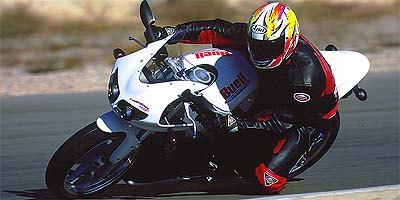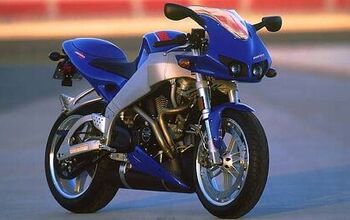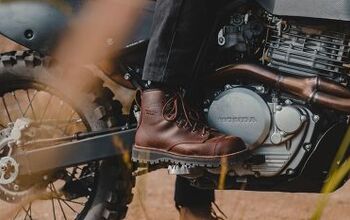First Ride: Buell XB9R Firebolt

Torrance, California, November 19, 2001 -- Ever wonder if that smell is bad meat or good cheese? Buell's new XB9R Firebolt is a lot like that. After spending part of a day riding the bike at Las Vegas Raceway, we're not sure if it's an excellent Buell or just a good sportbike. And then there's the issue of the name Firebolt. Given Buell's less than stellar reputation for reliability, we're not sure naming the bike after fires and hardware was such a brilliant marketing move. Then again, what do we know?
What we do know is that Buell isn't being complacent. The XB9R is a departure from standard Buell motorcycle design, but still maintains the trilogy of design that Erik Buell has insisted on since day one; mass centralization, low unsprung weight and chassis rigidity.
When we first laid eyes on the Firebolt, we had mixed feelings. Was Buell attempting to get into the ultra competitive supersport market? What was this bike positioned against? How were they going to market this bike? The questions continued. Thankfully however, most of those questions were answered during the press introduction at Las Vegas International Speedway's outer road course. The XB9R is not going against the supersports specifically, but rather against quite a broad genre of bikes. Though the bike's displacement and weight will no doubt draw comparisons against everything from Yamaha's R6 to Ducati's 996, Buell is trying to position this new bike against a number of non-supersport yet still high-performance machines such as the Ducati 900SS and Honda VTR1000 Superhawk. As for their marketing, its rather simple, relying on the old saying, "if you build it, they will come." Indeed, with the Firebolt, that just may be case.
So how does the Firebolt fit into the pantheon that is motorcycle goodness? From the get-go, Buell made it clear that this bike was designed for the active street rider - the kind of guy who rides primarily on the street and will visit a racetrack a few times a year. He will require a broad power band, compliant suspension, all-day comfort and light handling, something that will have no surprises. In order for Buell to accomplish these objectives, they started with a clean sheet of paper and drew up a design that would satisfy those very needs. In place of Buell's traditional trellis frame, there lies a large aluminum twin-spar unit. Gone is the standard gas tank, instead the fuel resides in the frame.
The 984 cc, two valve, pushrod, 45-degree, air-cooled V-twin remains. However, the new Firebolt includes a few things out of the ordinary like the rim-mounted disc brake and the oil sump that resides in the swingarm. Of course, if there's no gas tank, one is left to wonder what resides underneath the faux gas tank. Why, that'd be the airbox, of course. As the air gets crammed through the ram-air intake, it then gets shot up and over through a venturi into an 11 liter airbox. The airbox was designed to be of a "zero-resistance" type so that air will have an easy time of flowing through its cavity. After the box, air flows through a 45 mm throttle body and gets hooked up with a shot of fuel from an injector, one per cylinder. From there, the mixture slides over into the cylinder where it gets in close proximity with some new bits, namely the progressively wound valve springs and seven millimeter valve stems.
"Once in the cylinder the air gets mashed at a 10:1 compression ratio inside of its 88.4 x 79.38 mm chamber."
After combustion, the spent mixture gets out via staggered length stainless steel primary tubes. Buell went with the staggered length in order to better match natural scavenging qualities with the firing order of the motor. Finally, our friend air (or exhaust in this case) escapes into the atmosphere by an under-engine exhaust canister where it's happy to putt-putt onto your left boot when you have your feet on the ground.After the combustion process, power gets transferred in a fairly Buell-like way via belt drive through a five-speed transmission and a compensated clutch. However, the difference lies in the fact that the XB9R uses an idler pulley to maintain consistent belt tension. Major benefits to this system include extended belt life, minimal drive line lash and the fact that the rear wheel is placed in a fixed position.
As far as the trilogy goes, Buell wasn't joking around. They started with a rigid chassis, then they took every opportunity to shave off as much weight as possible. And if they couldn't take the weight off, they moved it as close to center as possible. For example, the rims are heat-treated, cast aluminum alloy. Nothing major there, but Buell have made the walls as thin as they could by removing as much excess material (i.e. spacers, washers) from the assembly as they could. The fairing is held onto the chassis via a one-piece "thixomolded" cast magnesium alloy unit. The rear subframe is a removable single-piece heat-treated aluminum alloy item.
Moving inward from the extremities you have two uncommon features; the rim-mounted brake as well as the swingarm oil sump. The disc was mounted to the rim in order to transfer the braking load away from the spokes and put it directly onto the rim and therefore, claims buell, straight to the ground. The oil was placed in the swingarm to allow for more flexibility in engine placement as well as to put the oil in direct air flow, helping keep things cool. To further curb excess heat, the cylinder heat sink fins have been increased in size while an oil cooler and a fan for the rear cylinder have been added.
As for the suspension, Buell ditched the under-motor rear shock in favor of a more traditionally positioned linkless Showa monoshock. Featuring a progressive spring, the shock features adjustable preload, compression and rebound damping adjustment that offers up five inches of travel at the axle. The front suspension is of the upside-down variety and is set-up with a steepish 21 degrees of rake and a scant 83 mm of trail (by comparison, the YZF-R6 has 81 while the CBR600F4i has 96). The forks also feature preload, compression and rebound damping adjustment.
Then there's the chassis. The aluminum twin-spar chassis features a fuel-in-the-frame design. This was done to maximize weight centralization while minimizing the performance-changing effects of fuel sloshing about in a traditional fuel tank. In order to make the frame hold the fuel, the chassis' cross section had to be increased which only added to an increase in rigidity. Buell's trademark Uniplanar engine mounts do an excellent job of curbing engine vibes, while still letting the rider know what's going on between the legs on a more visceral level. As is typical Buell fare, the swingarm is mounted directly to the engine.
When we first saw this machine, we thought, "hey, cool. If it works, great. But even if it doesn't, at least its different." Then we rode the bike and were pleasantly surprised that the bike actually worked well as was more than just a technical design exercise. When you first ride on a race track the first time, you generally take it easy and let yourself get comfortable on the track.
Likewise, when you ride a bike for the first time on a track that you're familiar with, you can generally step up the pace a bit quicker due to familiarity. However, when you're on a track you've never been on, on a bike you've never ridden, things get interesting.
Trying to juggle finding a good line with good body positioning whilst trying to figure out where the bike likes to be ridden in the power band while at the same time remembering, "oh yeah, this corner!" and "d'oh! I forgot about the decreasing radius," can be a taxing experience. It's times like these that you appreciate things like light handling, consistent suspension response and excellent mid-corner mannerisms. Thankfully, the XB9R has all of these traits. So what didn't the XB9R have? Well, we found the motor to be a bit lacking at the top.
"Although we didn't get a chance to ride the bike on the street, we have to remember that this bike was designed to be a street machine first, racebike a distant second."
As such, we were impressed by its low- to mid-range power and seamless fuel injection. Whenever you power out of a corner, you're first met with a healthy dose of power. Then slowly but surely, as the 7,500 rpm redline approaches, you notice the rate of acceleration decreasing. Granted, the amount of power available is good, though the motor doesn't have any noticeable top-end rush. Once again, another street vs. track compromise that was made in favor of the street. We feel this was a move in the right direction given the bike's overall direction.
The five speed transmission worked without any complaints, although we suffered from false neutrals until Buell technical staffers lowered our shift lever a few millimeters allowing us to get a better "push" on the lever. Once that was done, changing gears up or down was a no-brainer.
As for the brakes, we felt they were adequate, but didn't posses quite as much absolute braking force as we'd expect from the huge brake rotor. The 375 mm disc combined with the six-piston caliper gets the job done, but it isn't enough for us to come away in awe.
Nevertheless, we were impressed with the modulation as braking pressure and force application was very linear and extremely easy to control. Once again, these are traits that are far more valuable on the street than on the track. One trait that proved invaluable on the track was the stability of the chassis. It provided excellent feedback and the only limiting factor in the bike's lap times were the throw-away D207ZR street tires and, of course, rider skill.
Over pavement irregularities, bumps and seams, the bike tracked very consistently. Mid-corner corrections were effortless as was turn-in. The only problems we encountered in regards to the chassis was that, while turning in whilst still on the brakes, the bike felt very rigid as if the chassis might be binding itself up a bit. Hopefully a bit of rider-specific suspension set-up will alleviate most if not all of this trait. All in all, we were impressed at the level of ingenuity and thought that went into the design and construction of the machine. This level of precision can be felt when the bike is ridden on the track and will surely make it a good street bike. Indeed, once we were acclimated to the machine and its specific mannerisms, we were able to concentrate on going faster and faster on the track.
The ergonomics proved interesting as the seat-footpeg-grip position was fairly standard sportbike, though the angle of the grips was rather flat and more standard-ish than the turned-in angle found on most pure sportbikes. Although unique, we found it to be comfortable for use on the track. Our only qualm was that we felt it placed to much weight on the arms during braking. Another in-shape journalist even mentioned how sore his arms (specifically his triceps) were the following day. Once we receive our long-term test unit, we'll see how the ergonomics (as well as the rest of the bike) hold out during day-to-day operation.
We realize that Buell had to make numerous concessions between street and track. At the end of it all though, Buell's XB9R can be ridden hard on the track even though it was designed for the typical sporty street rider, a niche it fills remarkably well. Sure, its brakes could be a bit stronger and it could stand to gain a few horsepower up top, but its docile mannerisms and ease of maneuverability outweigh those faults. Buell's XB9R can be ridden hard on the track even though it was designed for the typical sporty street rider, a niche it fills remarkably well. It just may be time to trash a few of the misconceptions you have about Buells of yore. This new Firebolt is a serious bike that is a huge step forward from anything they've produced ever before. Now that we've ridden the Firebolt on the track, we can't wait to try it on the street.

Motorcycle.com presents an unrivaled combination of bike reviews and news written by industry experts
More by Motorcycle.com Staff





































Comments
Join the conversation